Minimal Monitoring of Improvements in Energy Performance after Envelope Renovation in Subsidized Single Family Housing in Madrid
Abstract
1. Introduction
Each Member State shall establish a long-term renovation strategy to support the renovation of the national stock of residential and non-residential buildings, both public and private, […] facilitating the cost-effective transformation of existing buildings into nearly zero-energy buildings.(European Parliament and EU Council, 2010)
2. Objectives
3. Case Study
Romany was entrusted with the design and construction of this planned community, located adjacent to two prior developments, Fuencarral A and B, designed respectively by Francisco Javier Sáenz de Oíza and Alejandro de la Sota. The idea was to build a neighborhood with a blend of low rises and single-family terrace units.[35]
- application of an external thermal insulation composite system (ETICS) to the façades, including 100 mm thick rock wool thermal insulation with thermal resistance λ = 0.036 W/mK;
- replacement of (fiber cement) roofing with (unspecified) 100 mm thermal insulation sandwiched between steel panels;
- replacement of window frames with new aluminum joinery featuring a thermal break;
- installation of low emissivity, 4/16/4 glazing with thermal transmittance (U-value), 1.1 W/m2K, and solar factor (g) 42.8 %.
4. Methodology
- The occupants were surveyed to determine their energy habits and define the monitoring strategy.
- Data were collected in situ, including:
- a monitoring campaign to establish the quality of the indoor environment in the two dwellings, conducted under the same outdoor weather conditions in the same months, which covered both the heating and the cooling seasons.
- energy consumption data as metered.
- The final stage consisted in comparing consumption as estimated by a simulation model for the urban complex to the data gathered in situ from the dwellings studied. The urban model used was based on estimated heating demand and a certain amount of energy for ‘other purposes’ (DHW, cooling, kitchen, lightning, and appliances). It was calibrated as proposed here, i.e., on the grounds of the consumption data recorded and a critical analysis of the habitability monitoring records.
- downloading information;
- information cleansing and standardization;
- data visualization.
4.1. User Survey
- data on the dwelling: floor area and age, ownership, and general questions about construction and window type;
- data on the household: number of inhabitants, mean occupancy, ventilation habits, and heating element use; winter- and summer-time comfort in the home; improvements and dwelling-scale energy saving measures adopted;
- data on DHW, heating and cooling, energy sources, and respective facilities;
- data from electricity and gas bills, request for one electricity and one gas bill for each dwelling to determine the uniform network supply point code (Spanish initials, CUPS);
- compilation of technical information on dwelling B energy renovation.
4.2. Indoor Environment Quality Monitoring
4.3. Energy Consumption Quantification
- Consumption was distributed uniformly across the number of days specified on the invoice.
- Those values were then summed and regrouped monthly.
- The first and last periods were disregarded, for they did not normally consist in full months.
- Mean monthly and yearly values were computed for each dwelling.
4.4. Weather Data
4.5. Data for the Urban Analysis
- digital aerial ortho-photographs forming part of the National Geographic Institute’s Plan for Land Use Observation [55];
- digital cartography published by the Cadastre’s virtual office [56];
- ‘Metodología de Evaluación de Pérdidas Energéticas’ [methodology for assessing energy loss (Spanish initials, MEPEC)], a tool for estimating heating energy demand developed under the Habita_RES project [51];
- monitoring data records and consumption metered in the two units.
5. Results and Discussion
5.1. User Surveys
5.2. Indoor Environment Quality
5.2.1. Environmental Comfort: Temperature (T °C)
5.2.2. Environmental Comfort: Relative Humidity (%)
5.2.3. Air Quality
5.3. Power Consumption
5.3.1. Natural Gas Consumption
5.3.2. Electric Power Consumption
5.4. Urban Analysis
5.4.1. Heating Demand for the Complex
5.4.2. Total Consumption in the Urban Complex
6. Conclusions
Author Contributions
Funding
Institutional Review Board Statement
Informed Consent Statement
Data Availability Statement
Acknowledgments
Conflicts of Interest
References
- European Parliament; UE Council. Directive 2018/844 of the European Parliament and of the Council of 30 May 2018 Amending Directive 2010/31/EU on the Energy Performance of Buildings and Directive 2012/27/EU on Energy Efficiency (Text with EEA Relevance); European Parliament: Strasbourg, France, 2018; Volume OJ L.
- European Parliament; UE Council. Directive 2012/27/EU of the European Parliament and of the Council of 25 October 2012 on Energy Efficiency, Amending Directives 2009/125/EC and 2010/30/EU and Repealing Directives 2004/8/EC and 2006/32/EC (Text with EEA Relevance); European Parliament: Strasbourg, France, 2012; Volume OJ L.
- European Parliament; UE Council. Directive 2010/31/EU of the European Parliament and of the Council of 19 May 2010 on the Energy Performance of Buildings; European Parliament: Strasbourg, France, 2010; Volume OJ L.
- European Commission. A European Green Deal—European Commission. 2020. Available online: https://ec.europa.eu/info/strategy/priorities-2019-2024/european-green-deal_en (accessed on 17 July 2020).
- European Commission. Renovation Wave, Energy—European Commission. 4 June 2020. Available online: https://ec.europa.eu/energy/topics/energy-efficiency/energy-efficient-buildings/renovation-wave_en (accessed on 17 July 2020).
- Ministerio de Fomento. ERESEE 2014. Estrategia a Largo Plazo para la Rehabilitación Energética en el Sector de la Edificación en España. Secretaría de Estado de Infraestructuras, Transporte y Vivienda. 2014. Available online: https://www.mitma.gob.es/ministerio/planes-estrategicos/estrategia-a-largo-plazo-para-la-rehabilitacion-energetica-en-el-sector-de-la-edificacion-en-espana/eresee_2014 (accessed on 22 November 2019).
- Ministerio de Fomento. ERESEE 2017. Actualización de la Estrategia a Largo Plazo para la Rehabilitación Energética en el Sector de la Edificación en España. Secretaría de Estado de Infraestructuras, Transporte y Vivienda. 2017. Available online: https://www.mitma.gob.es/ministerio/planes-estrategicos/estrategia-a-largo-plazo-para-la-rehabilitacion-energetica-en-el-sector-de-la-edificacion-en-espana/eresee_2017 (accessed on 22 November 2019).
- Ministerio de Transportes, Movilidad y Agenda Urbana. ERESEE 2020. Actualización 2020 de la Estrategia a Largo Plazo para la Rehabilitación Energética en el Sector de la Edificación en España. 2020. Available online: https://www.mitma.es/el-ministerio/planes-estrategicos/estrategia-a-largo-plazo-para-la-rehabilitacion-energetica-en-el-sector-de-la-edificacion-en-espana (accessed on 16 July 2020).
- Escandón, R.; Suárez, R.; Sendra, J.J. On the assessment of the energy performance and environmental behaviour of social housing stock for the adjustment between simulated and measured data: The case of mild winters in the Mediterranean climate of southern Europe. Energy Build. 2017, 152, 418–433. [Google Scholar] [CrossRef]
- Howden-Chapman, P.; Matheson, A.; Crane, J.; Viggers, H.; Cunningham, M.; Blakely, T.; Cunningham, C.; Woodward, A.; Saville-Smith, K.; O’Dea, D.; et al. Effect of insulating existing houses on health inequality: Cluster randomised study in the community. BMJ 2007, 334, 460. [Google Scholar] [CrossRef] [PubMed]
- Thomson, H.; Thomas, S.; Sellström, E.; Petticrew, M. Housing Improvements for Health and Associated Socio-Economic Outcomes: A Systematic Review. Campbell Syst. Rev. 2013, 9, 1–348. [Google Scholar] [CrossRef]
- Cuchí, A.; Sweatman, P. Informe GTR 2012. Una Visión-País Para El Sector De La Edificación En España. Plan de Acción Para un Nuevo Sector de la Vivienda; Grupo de Trabajo sobre Rehabilitación (GTR): Madrid, Spain, 2012. [Google Scholar]
- Cuchí, A.; Sweatman, P. Informe GTR 2014. Estrategia para la Rehabilitación. Grupo de Trabajo Sobre Rehabilitación (GTR). 2014. Available online: https://gbce.es/recursos/informe-gtr-2014/ (accessed on 30 November 2019).
- NBE-CT-79; NBE-CT-79. Condiciones Térmicas de los Edificios; Presidencia del Gobierno: Madrid, Spain, 1979. [Google Scholar]
- CTE-DB-HE. Código Técnico de la Edificación. Documento Básico HE Ahorro de Energía; Gobierno de España: Madrid, Spain, 2019. [Google Scholar]
- Kurtz, F.; Monzón, M.; López-Mesa, B. Obsolescencia de la envolvente térmica y acústica de la vivienda social de la postguerra española en áreas urbanas vulnerables. El caso de Zaragoza. Inf. Construcción 2015, 67, 021. [Google Scholar] [CrossRef]
- Domínguez, S.; Sendra, J.J.; Oteiza San José, I. La Envolvente Energética de la Vivienda Social en el Periodo 1939–1979. Caso de Sevilla; Consejo Superior de Investigaciones Científicas: Madrid, Spain, 2016.
- Sánchez-Guevara Sánchez, C.; Núñez Peiró, M.; Neila González, F.J. Urban Heat Island and Vulnerable Population. The Case of Madrid. In Sustainable Development and Renovation in Architecture, Urbanism and Engineering; Mercader-Moyano, P., Ed.; Springer International Publishing: Cham, Switzerland, 2017; pp. 3–13. [Google Scholar]
- Sanz Fernández, A.; Gómez Muñoz, G.; Sánchez-Guevara Sánchez, C.; Núñez Peiró, M. Estudio Técnico Sobre Pobreza Energética en Madrid; Escuela Nacional de Salud: Madrid, Spain, 2017; p. 186. [Google Scholar]
- Martín-Consuegra, F.; Gómez Giménez, J.M.; Alonso, C.; Córdoba Hernández, R.; Hernández Aja, A.; Oteiza, I. Multidimensional index of fuel poverty in deprived neighbourhoods. Case study of Madrid. Energy Build. 2020, 110205. [Google Scholar] [CrossRef]
- Giancola, E.; Soutullo, S.; Olmedo, R.; Heras, M.R. Evaluating rehabilitation of the social housing envelope: Experimental assessment of thermal indoor improvements during actual operating conditions in dry hot climate, a case study. Energy Build. 2014, 75, 264–271. [Google Scholar] [CrossRef]
- Hills, J. Final report of the Fuel Poverty Review. 2012. Available online: https://www.gov.uk/government/publications/final-report-of-the-fuel-poverty-review (accessed on 22 May 2017).
- de Luxán García de Diego, M.; Gómez Muñoz, G.; López Román, E. Cuentas energéticas no habituales en edificación residencial. Inf. Construcción 2015, 67, 9. [Google Scholar] [CrossRef]
- Aranda, J.; Zabalza, I.; Conserva, A.; Millán, G. Analysis of Energy Efficiency Measures and Retrofitting Solutions for Social Housing Buildings in Spain as a Way to Mitigate Energy Poverty. Sustainability 2017, 9, 1869. [Google Scholar] [CrossRef]
- Mata, E.; Sasic Kalagasidis, A.; Johnsson, F. Building-stock aggregation through archetype buildings: France, Germany, Spain and the UK. Build. Environ. 2014, 81, 270–282. [Google Scholar] [CrossRef]
- Mata, E.; Medina Benejam, G.; Sasic Kalagasidis, A.; Johnsson, F. Modelling opportunities and costs associated with energy conservation in the Spanish building stock. Energy Build. 2015, 88, 347–360. [Google Scholar] [CrossRef]
- Loga, T.; Stein, B.; Diefenbach, N. TABULA building typologies in 20 European countries—Making energy-related features of residential building stocks comparable. Energy Build. 2016, 132, 4–12. [Google Scholar] [CrossRef]
- Golubchikov, O.; Deda, P. Governance, technology, and equity: An integrated policy framework for energy efficient housing. Energy Policy 2012, 41, 733–741. [Google Scholar] [CrossRef]
- Demski, C.; Thomas, G.; Becker, S.; Evensen, D.; Pidgeon, N. Acceptance of energy transitions and policies: Public conceptualisations of energy as a need and basic right in the United Kingdom. Energy Res. Soc. Sci. 2019, 48, 33–45. [Google Scholar] [CrossRef]
- Grillone, B.; Danov, S.; Sumper, A.; Cipriano, J.; Mor, G. A review of deterministic and data-driven methods to quantify energy efficiency savings and to predict retrofitting scenarios in buildings. Renew. Sustain. Energy Rev. 2020, 131, 110027. [Google Scholar] [CrossRef]
- Filippi Oberegger, U.; Pernetti, R.; Lollini, R. Bottom-up building stock retrofit based on levelized cost of saved energy. Energy Build. 2020, 210, 109757. [Google Scholar] [CrossRef]
- Alonso, C.; Oteiza, I.; García-Navarro, J.; Martín-Consuegra, F. Energy consumption to cool and heat experimental modules for the energy refurbishment of façades. Three case studies in Madrid. Energy Build. 2016, 126, 252–262. [Google Scholar] [CrossRef]
- Alonso, C.; Oteiza, I.; Martín-Consuegra, F.; Frutos, B. Methodological proposal for monitoring energy refurbishment. Indoor environmental quality in two case studies of social housing in Madrid, Spain. Energy Build. 2017, 155 (Suppl. C), 492–502. [Google Scholar] [CrossRef]
- Cuerda, E.; Guerra-Santin, O.; Sendra, J.J.; Neila, F.C. Understanding the performance gap in energy retrofitting: Measured input data for adjusting building simulation models. Energy Build. 2020, 209, 109688. [Google Scholar] [CrossRef]
- Esteban Maluenda, A.M. La vivienda social española en la década de los 50: Un paseo por los poblados dirigidos de Madrid. Cuad. Notas 1999, 7, 55–80. [Google Scholar]
- Centellas, M.; Jordá, C.; Landrove, S. Docomomo Ibérico, La Vivienda Moderna: Registro DOCOMOMO Ibérico, 1925–1965. Barcelona; Fundación DOCOMOMO Ibérico: Madrid, Spain, 2009. [Google Scholar]
- Moya, L.; Monjo, J.; Díez, A. La arquitectura ordinaria del siglo XX como patrimonio cultural: Tres barrios de promoción oficial de Madrid. Rev. EURE Rev. Estud. Urbano Reg. 2017, 43. [Google Scholar] [CrossRef]
- Carratt, A.; Kokogiannakis, G.; Daly, D. A critical review of methods for the performance evaluation of passive thermal retrofits in residential buildings. J. Clean. Prod. 2020, 263, 121408. [Google Scholar] [CrossRef]
- Madonna, F.; Quaglia, P.; Corrado, V.; Croci, L. Influence of Comfort Expectations on Building Energy Need. Energy Procedia 2017, 140, 265–276. [Google Scholar] [CrossRef]
- Elsharkawy, H.; Zahiri, S. The significance of occupancy profiles in determining post retrofit indoor thermal comfort, overheating risk and building energy performance. Build. Environ. 2020, 172, 106676. [Google Scholar] [CrossRef]
- Du, J.; Pan, W.; Yu, C. In-situ monitoring of occupant behavior in residential buildings—A timely review. Energy Build. 2020, 212, 109811. [Google Scholar] [CrossRef]
- Dovjak, M.; Slobodnik, J.; Krainer, A. Consequences of energy renovation on indoor air quality in kindergartens. Build. Simul. 2020, 13, 691–708. [Google Scholar] [CrossRef]
- Korsavi, S.S.; Montazami, A.; Mumovic, D. Indoor air quality (IAQ) in naturally-ventilated primary schools in the UK: Occupant-related factors. Build. Environ. 2020, 180. [Google Scholar] [CrossRef]
- Liang, W.; Zhao, B.; Liu, J.; Pei, J. Can carbon dioxide be a good indicator for formaldehyde in residences?—Monte Carlo modeling for a whole year. Sci. Technol. Built Environ. 2020, 26, 749–762. [Google Scholar] [CrossRef]
- Código Técnico de la Edificación. Documento Básico HS Salubridad 2019. Available online: https://www.codigotecnico.org/pdf/Documentos/HS/DBHS.pdf (accessed on 29 December 2020).
- Wöhler, Registrador de CO2 CDL 210. 2020. Available online: https://www.pce-iberica.es/medidor-detalles-tecnicos/instrumento-de-registrador/registrador-cdl210.htm (accessed on 11 May 2020).
- Besagni, G.; Borgarello, M. The determinants of residential energy expenditure in Italy. Energy 2018, 165, 369–386. [Google Scholar] [CrossRef]
- Wahlström, M.H.; Hårsman, B. Residential energy consumption and conservation. Energy Build. 2015, 102, 58–66. [Google Scholar] [CrossRef]
- Martín-Consuegra, F.; Gouveia, J.P.; de Frutos, F.; Alonso, C.; Oteiza, I. Energy consumption and comfort gap in social housing in Madrid, through smart meters and surveys information. Presented at the 10th European Conference on Energy Efficiency and Sustainability in Architecture and Planning—3rd International Congress on Advanced Construction, Vitoria-Gasteiz, Spain, 11–12 September 2019. [Google Scholar]
- Oteiza, I. Proyecto Habita_res—(2018–2021) Proyecto de Investigación BIA2017-83231-C2-1-R. Nueva Herramienta Integrada de Evaluación para Áreas Urbanas Vulnerables. Hacia la Autosuficiencia Energética y a Favor de un Modelo de Habitabilidad Biosaludable 2021. 2018. Available online: https://proyectohabitares.ietcc.csic.es (accessed on 15 February 2020).
- Martín-Consuegra, F.; de Frutos, F.; Oteiza, I.; Hernández Aja, A. Use of cadastral data to assess urban scale building energy loss. Application to a deprived quarter in Madrid. Energy Build. 2018, 171, 50–63. [Google Scholar] [CrossRef]
- International Organization for Standardization. ISO 13790:2008—Energy Performance of Buildings—Calculation of Energy Use for Space Heating and Cooling. Available online: https://www.iso.org/standard/41974.html (accessed on 29 December 2020).
- IDAE. Proyecto SECH-SPAHOUSEC. Análisis del Consumo Energético del Sector Residencial en España. Informe Final, Instituto para la Diversificación y Ahorro de Energía. 2011. Available online: www.idae.es/uploads/documentos/documentos_informe_spahousec_acc_f68291a3.pdf (accessed on 29 December 2020).
- IDAE. SPAHOUSEC II: Análisis Estadístico del Consumo de gas Natural en las Viviendas Principales con Calefacción Individual, Instituto para la Diversificación y Ahorro de Energía. 2019. Available online: https://idae.es/publicaciones/spahousec-ii-analisis-estadistico-del-consumo-de-gas-natural-en-las-viviendas (accessed on 1 December 2019).
- IGN. Plan Nacional de Ortofotografía Aérea; Instituto Geográfico Nacional: Madrid, Spain, 2016. [Google Scholar]
- Sede Electrónica de Catastro. Servicios Web Libres del Catastro. Dirección General de Catastro, 13 January 2011. Available online: http://www.catastro.minhap.gob.es/ws/Webservices_Libres.pdf (accessed on 9 May 2017).
- Tabatabaei Sameni, S.M.; Gaterell, M.; Montazami, A.; Ahmed, A. Overheating investigation in UK social housing flats built to the Passivhaus standard. Build. Environ. 2015, 92, 222–235. [Google Scholar] [CrossRef]
- Roetzel, A.; Tsangrassoulis, A.; Dietrich, U.; Busching, S. On the influence of building design, occupants and heat waves on comfort and greenhouse gas emissions in naturally ventilated offices. A study based on the EN 15251 adaptive thermal comfort model in Athens, Greece. Build. Simul. 2010, 3, 87–103. [Google Scholar] [CrossRef]
- Rodríguez Trejo, S.; Vega Sánchez, S.; Acha Román, C. Evaluation of Ventilation and IAQ Parameters Measured in Social Housing in Madrid. Presented at the AIVC Conference 2015, Madrid, Spain, 23–24 September 2015; Available online: http://oa.upm.es/41860/ (accessed on 22 May 2017).
- Kinnane, O.; Sinnott, D.; Turner, W.J.N. Evaluation of passive ventilation provision in domestic housing retrofit. Build. Environ. 2016, 106, 205–218. [Google Scholar] [CrossRef]
- Broderick, Á.; Byrne, M.; Armstrong, S.; Sheahan, J.; Coggins, A.M. A pre and post evaluation of indoor air quality, ventilation, and thermal comfort in retrofitted co-operative social housing. Build. Environ. 2017, 122, 126–133. [Google Scholar] [CrossRef]
- Frutos, F.; Martin-Consuegra, F.; Oteiza, I.; Alonso, C.; Frutos, B.; Galeano, J. Energy efficiency and comfort on a deprived neighbourhood in Madrid (Spain). Presented at the PLEA 2020 A Coruña. Planing Post Carbon Cities, A Coruña, Spain, 1–3 September 2020. [Google Scholar]
- CTE-DB-HE. Código Técnico de la Edificación. Documento Básico HE Ahorro de Energía 2013; Gobierno de España: Madrid, Spain, 2013. [Google Scholar]
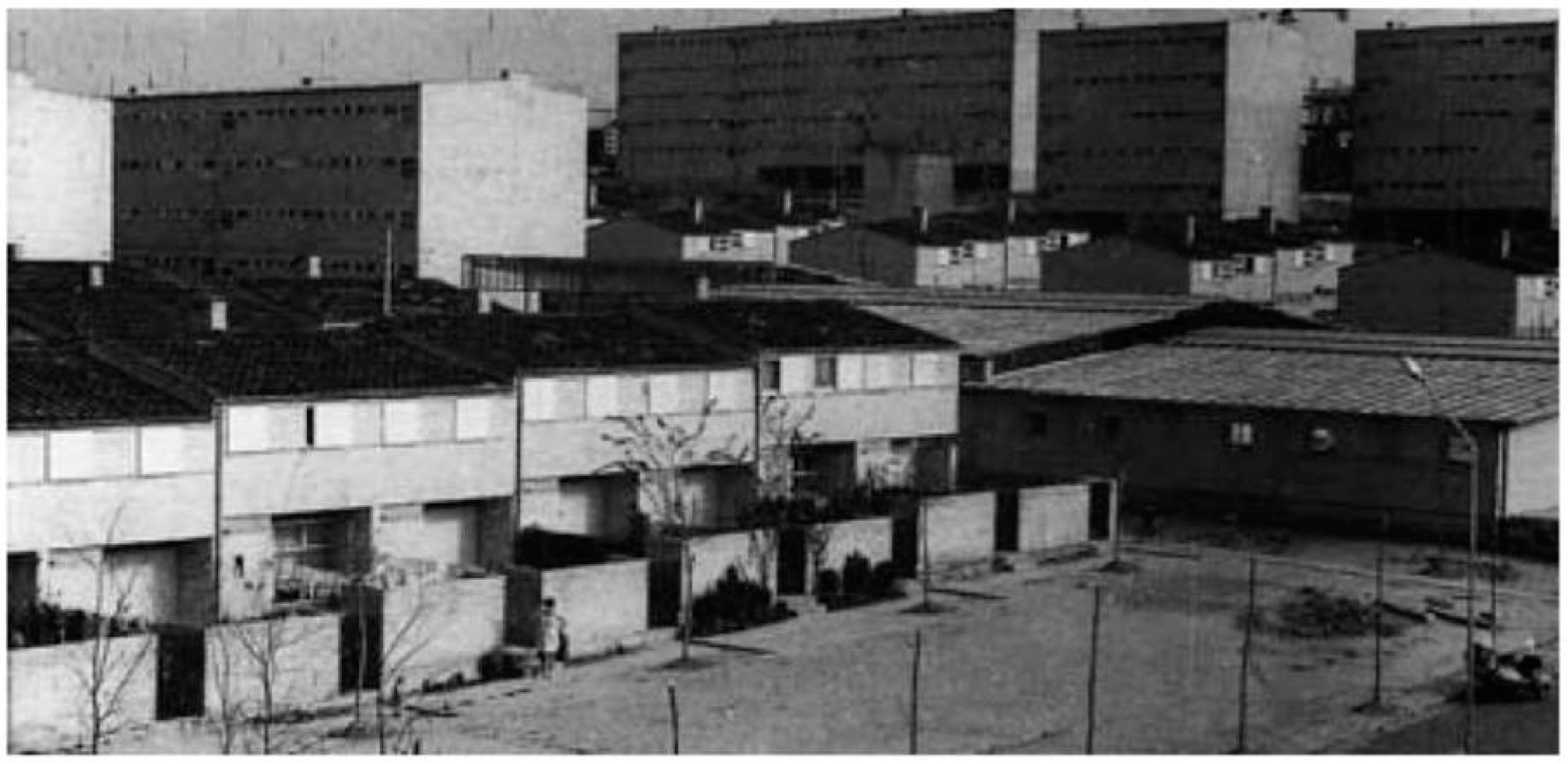
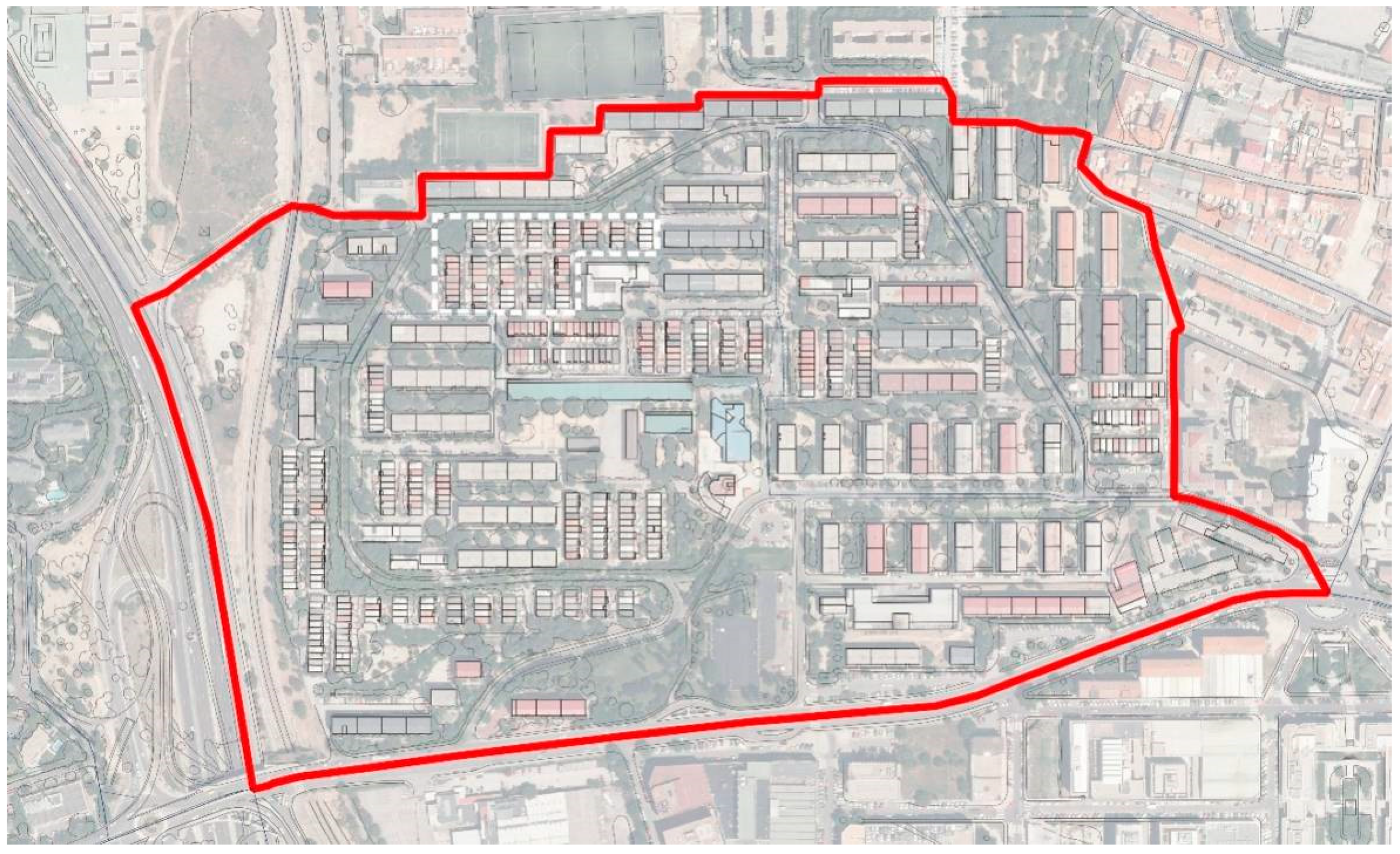

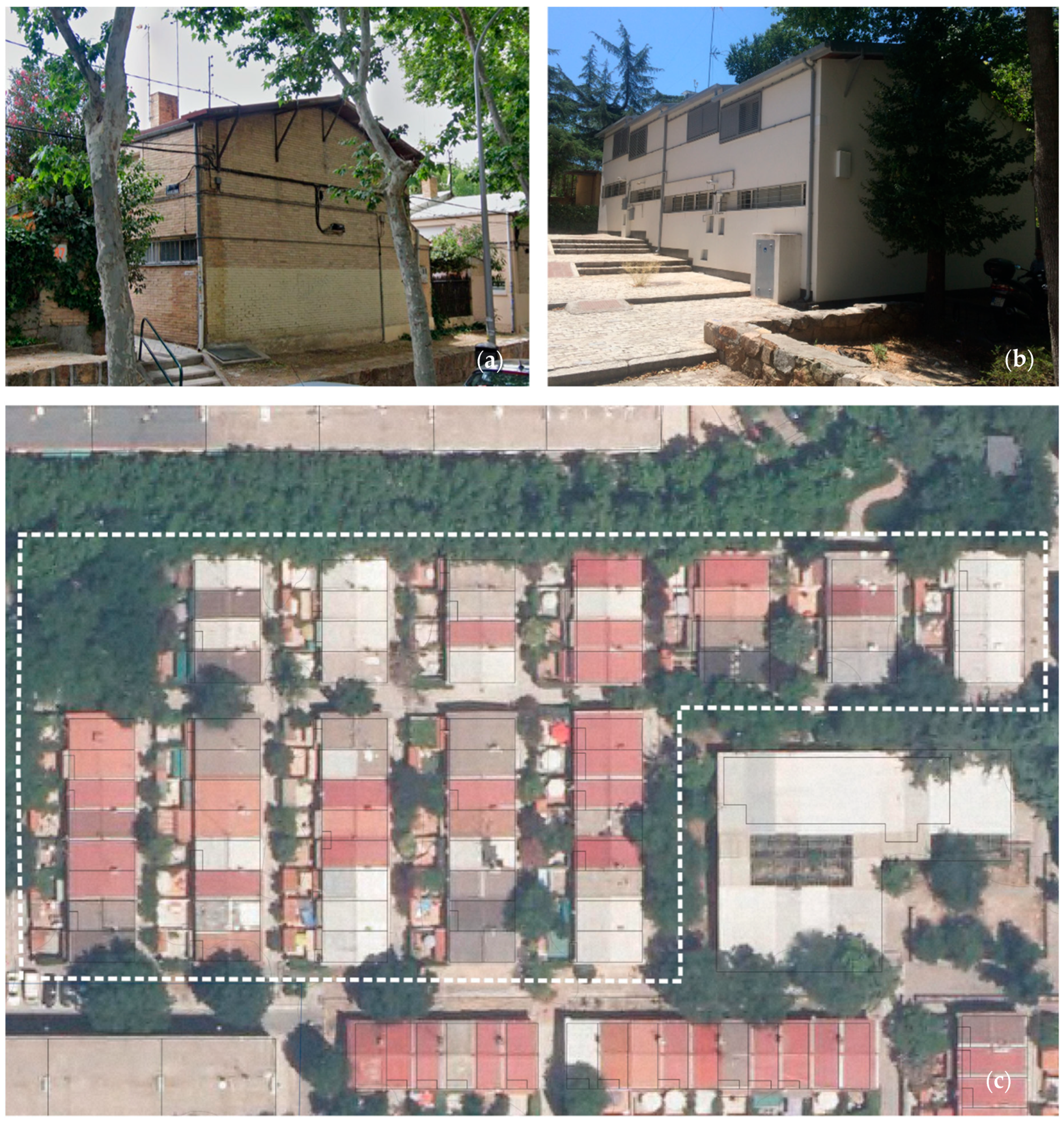
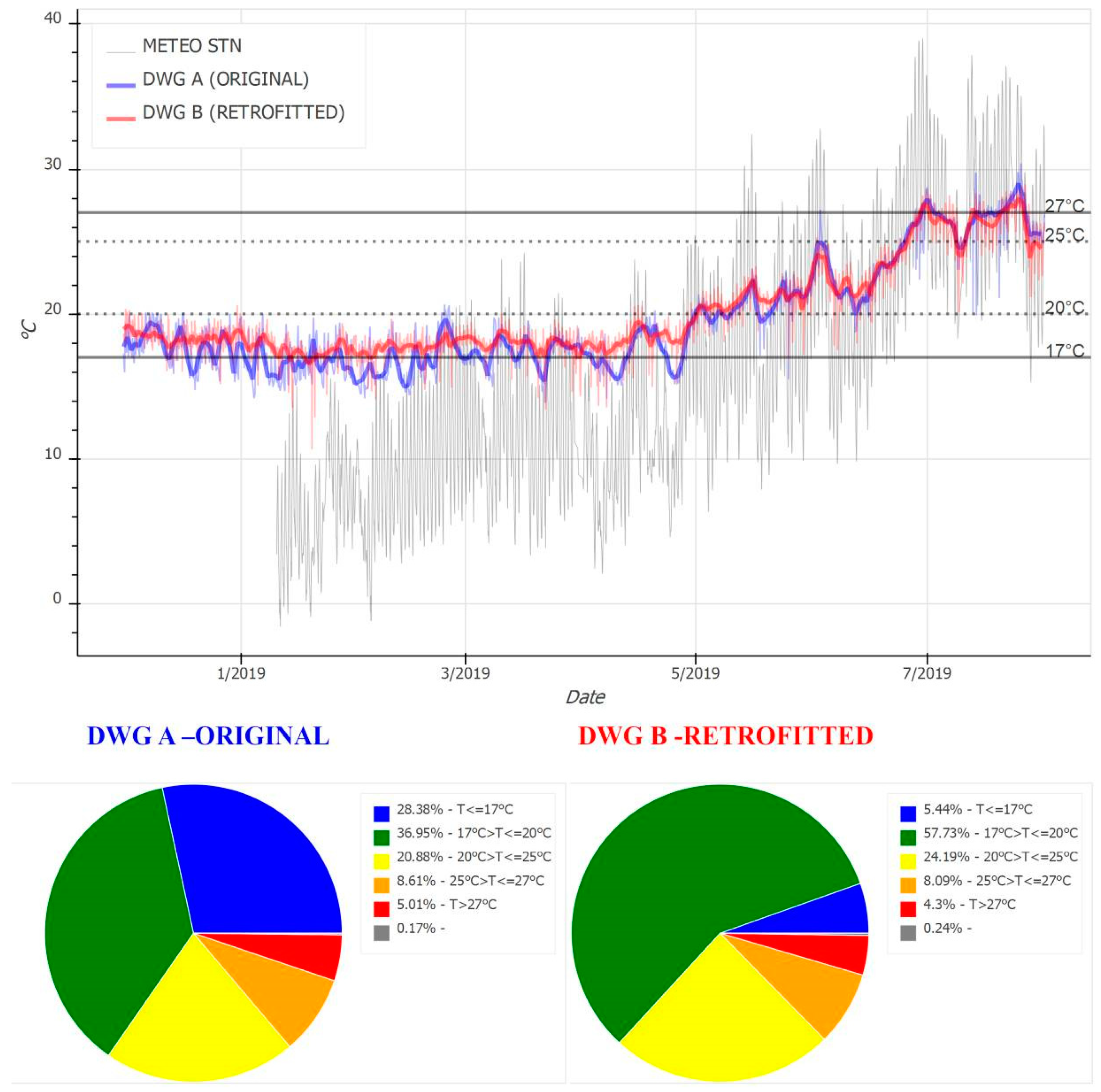
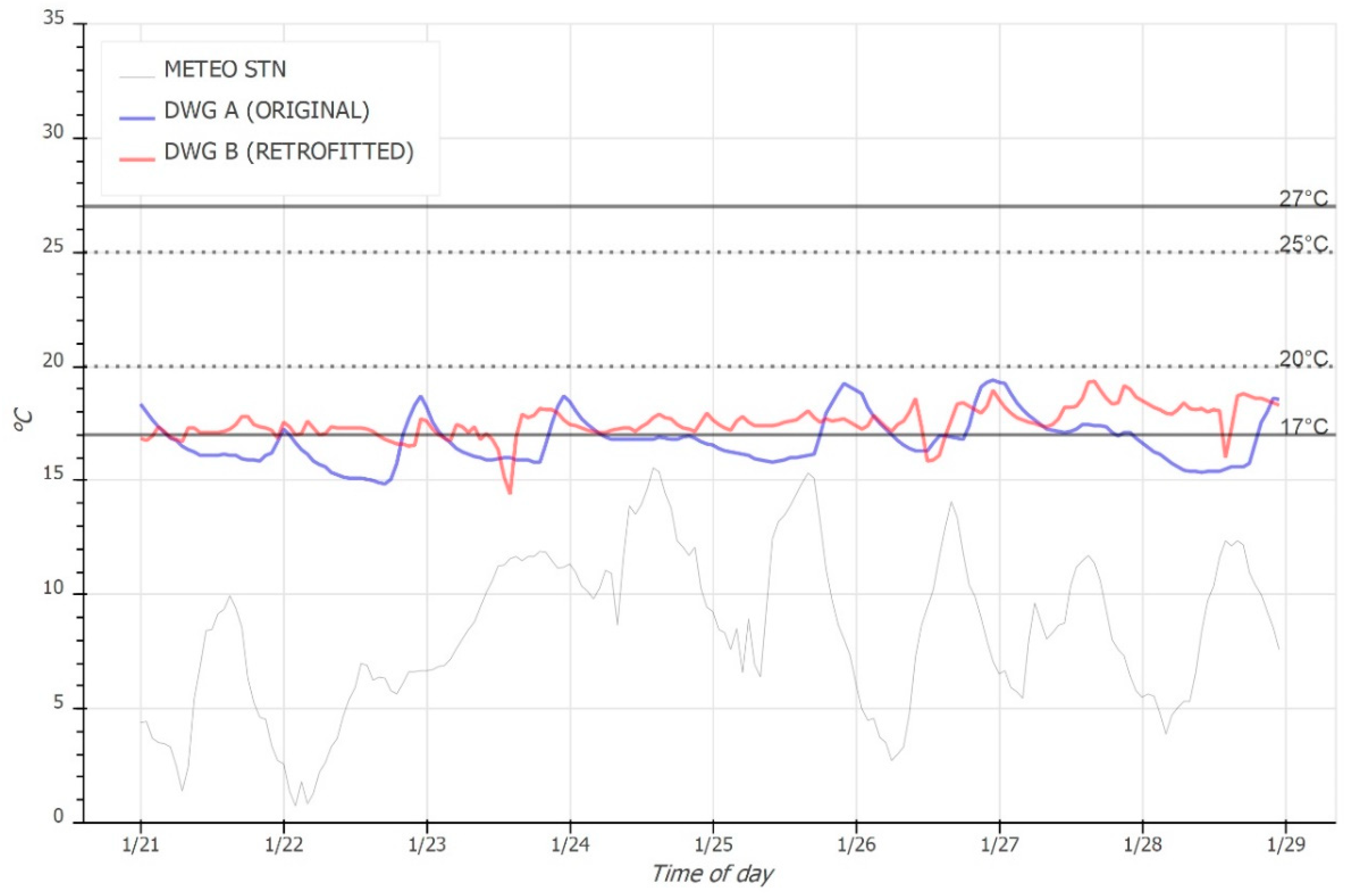
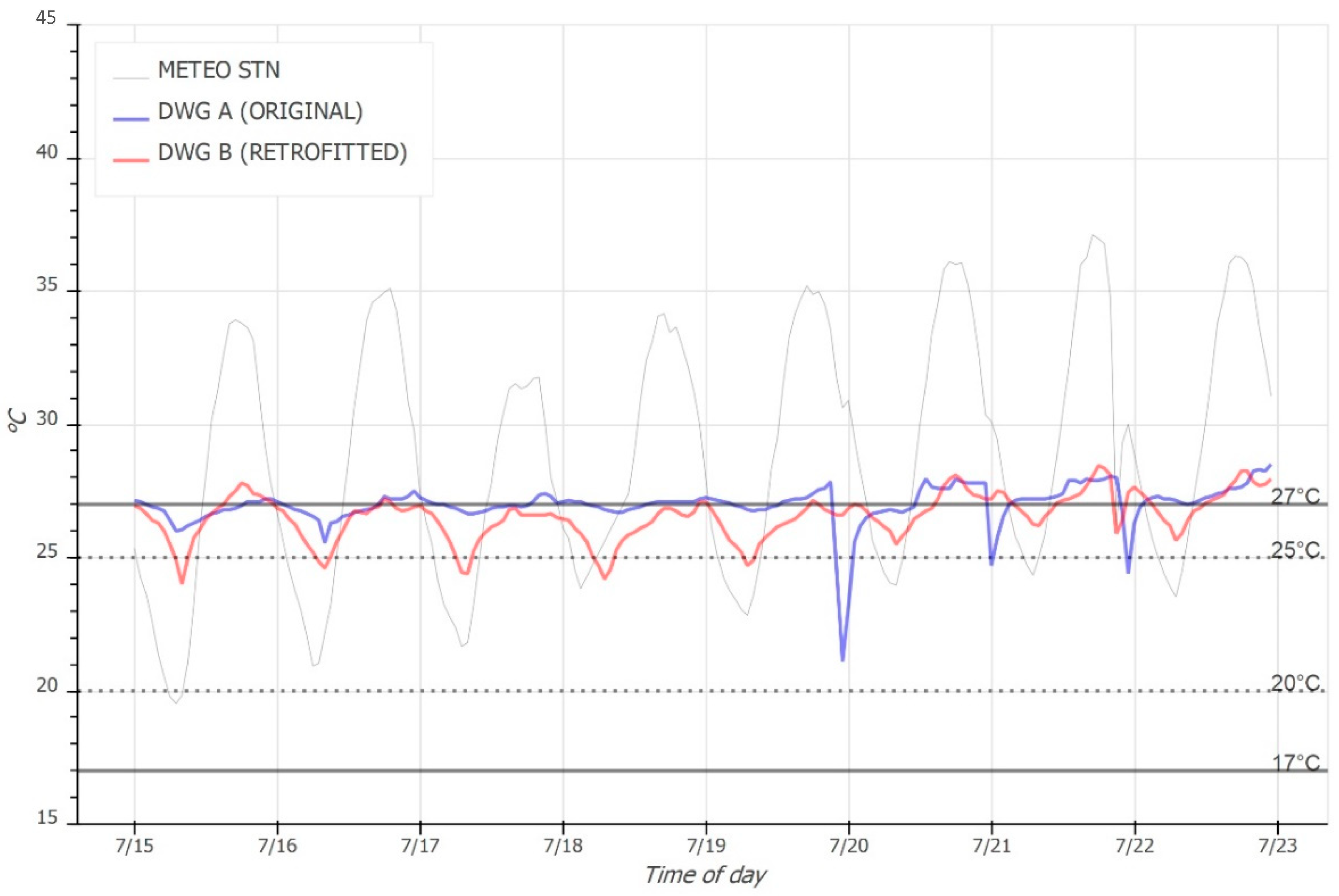
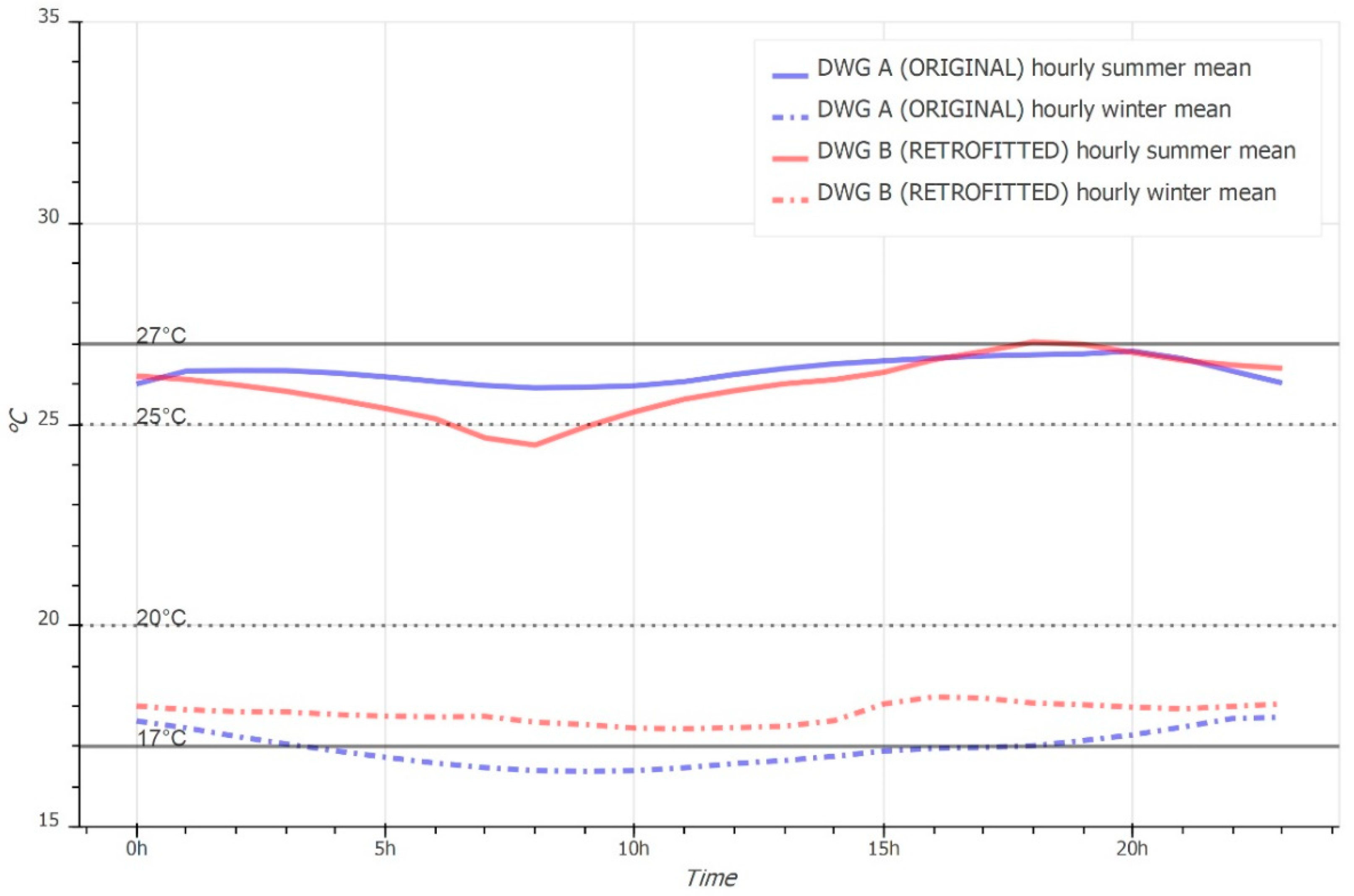
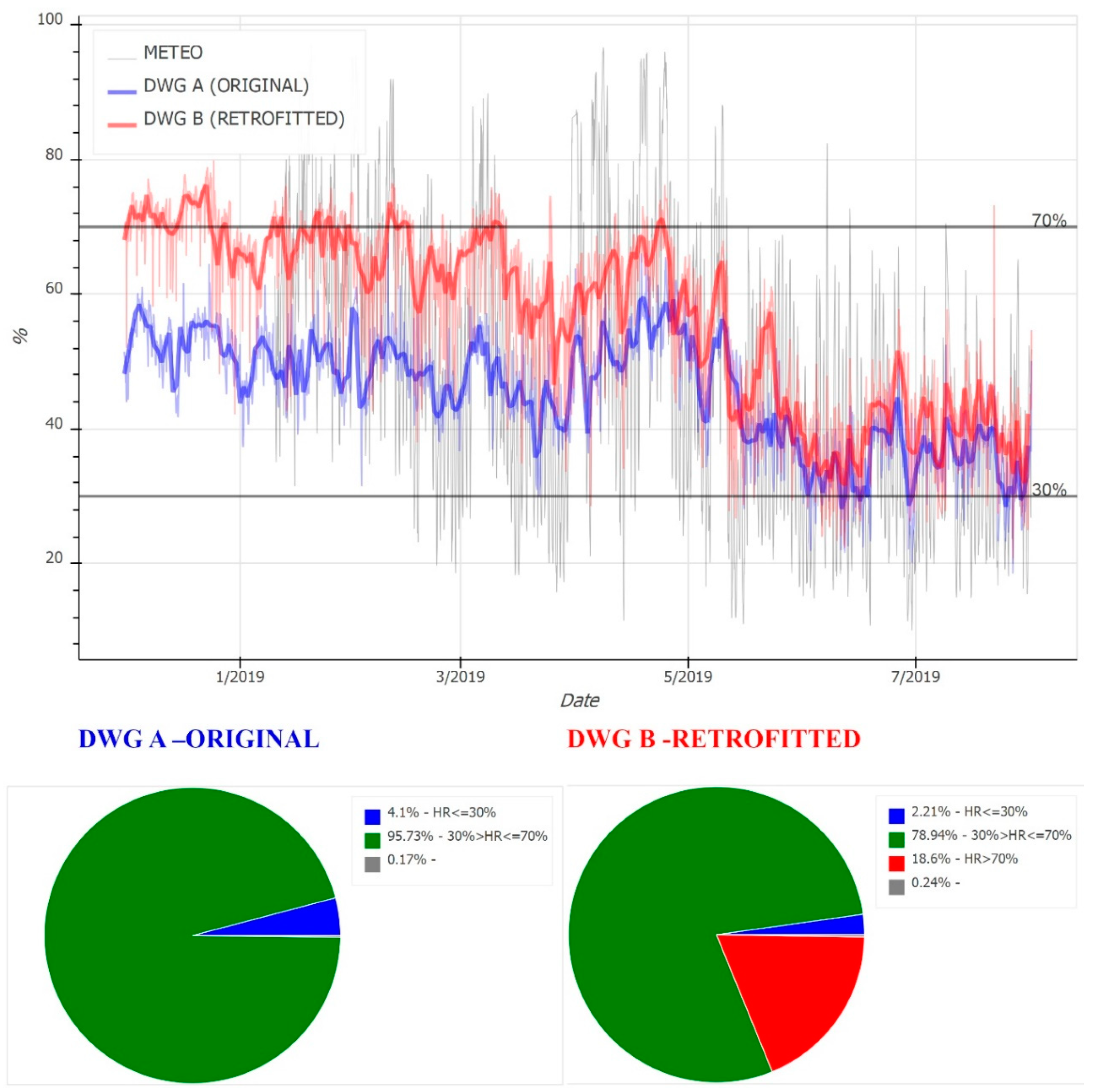
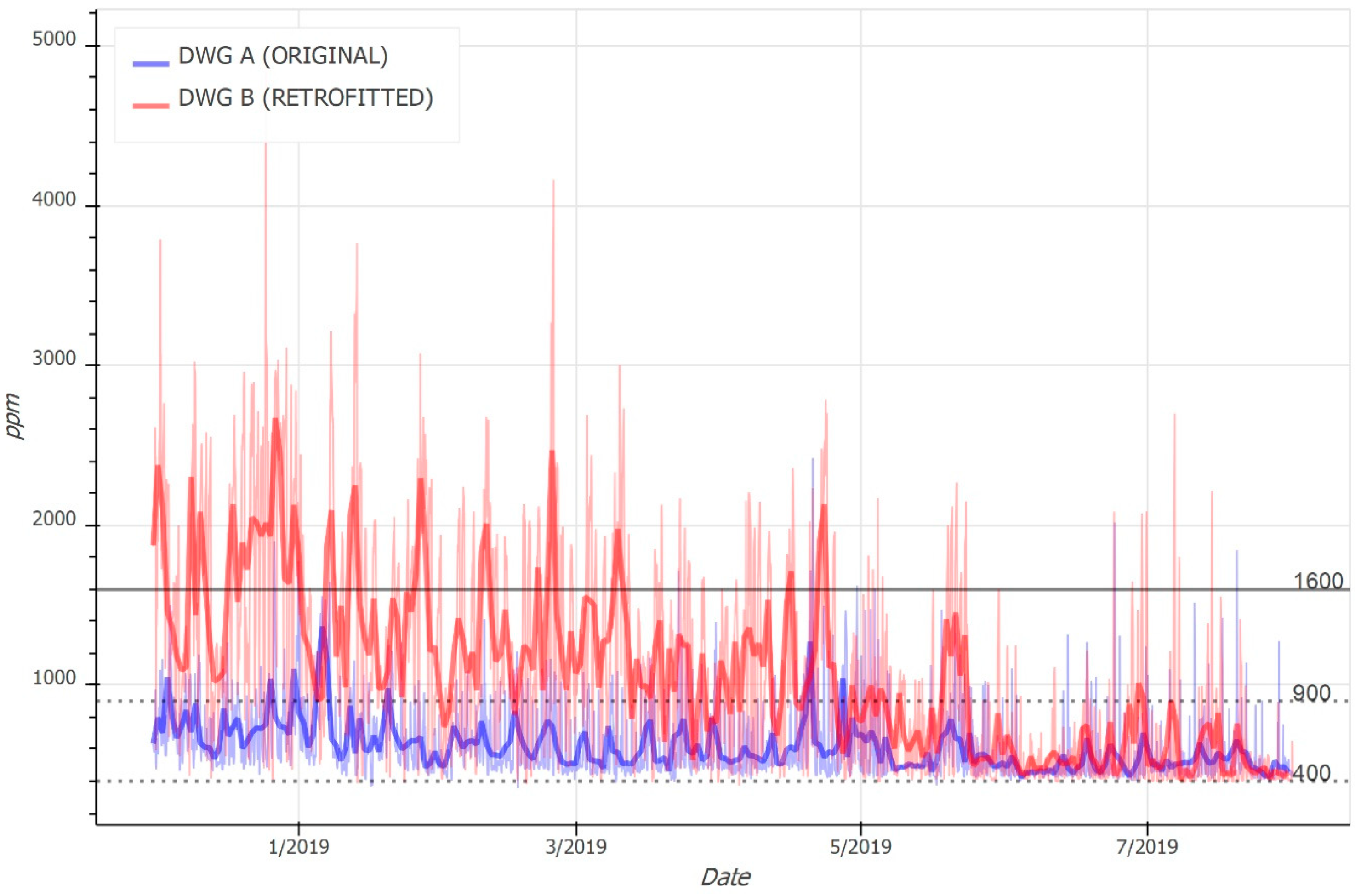
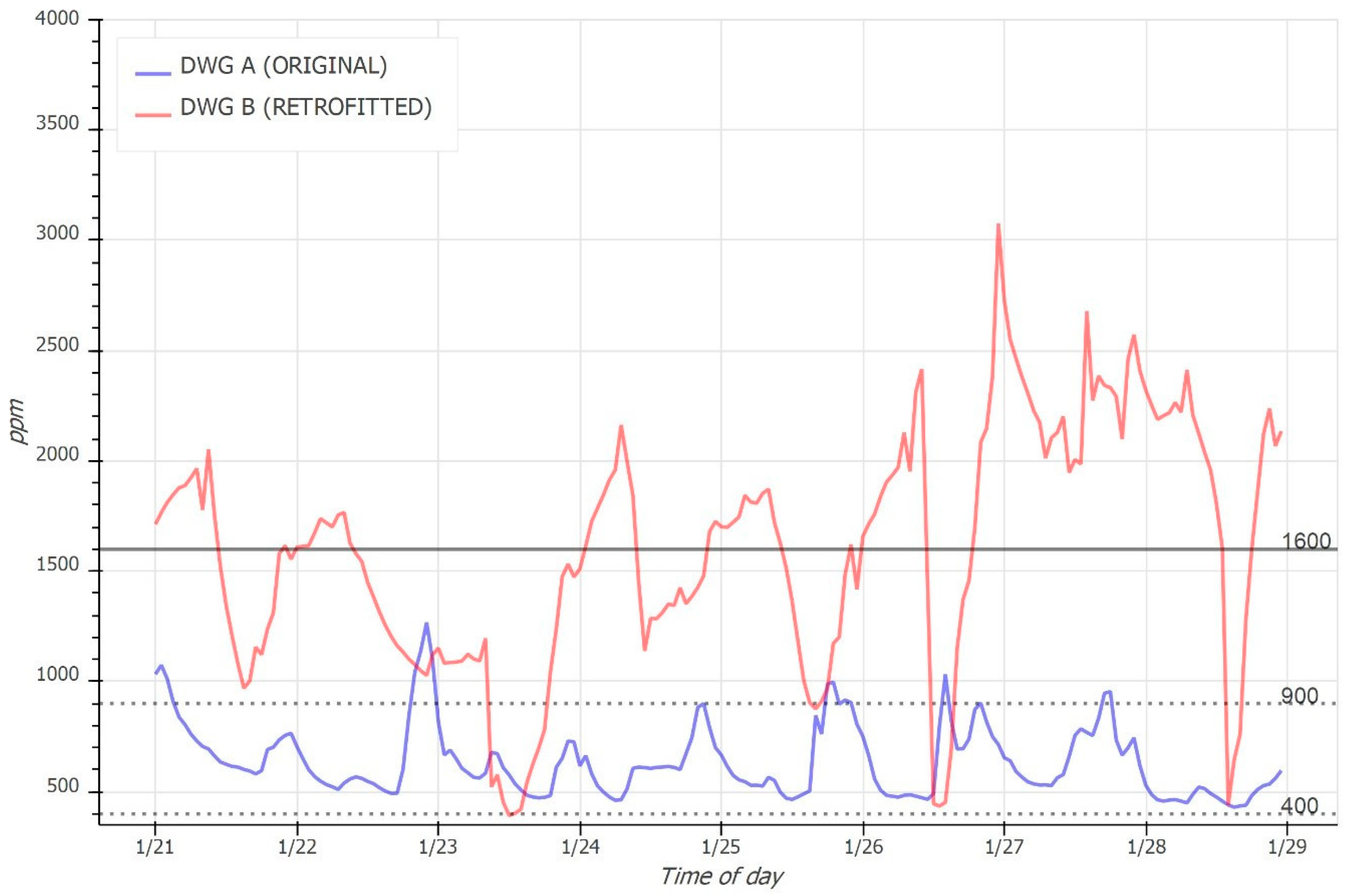
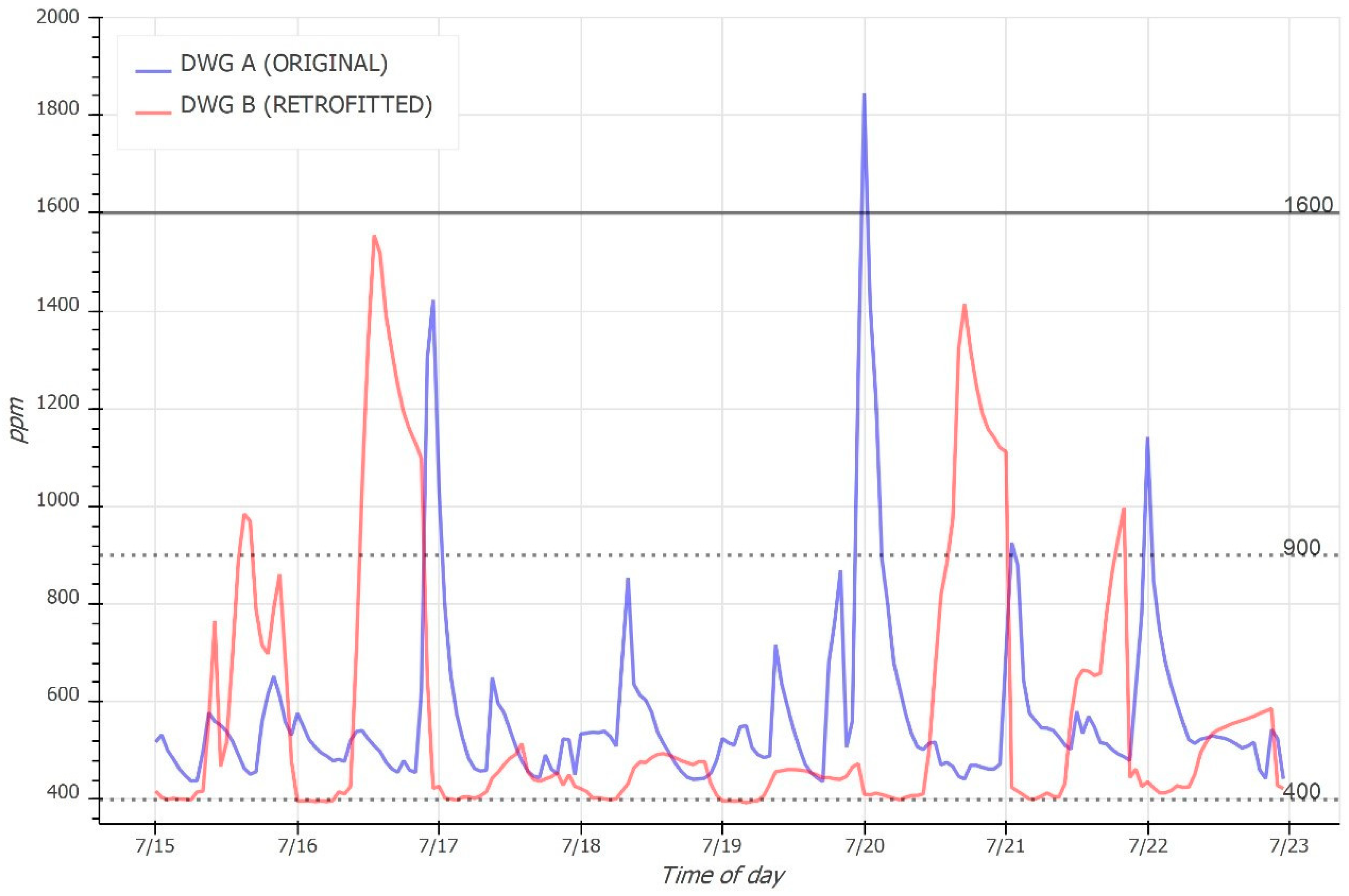
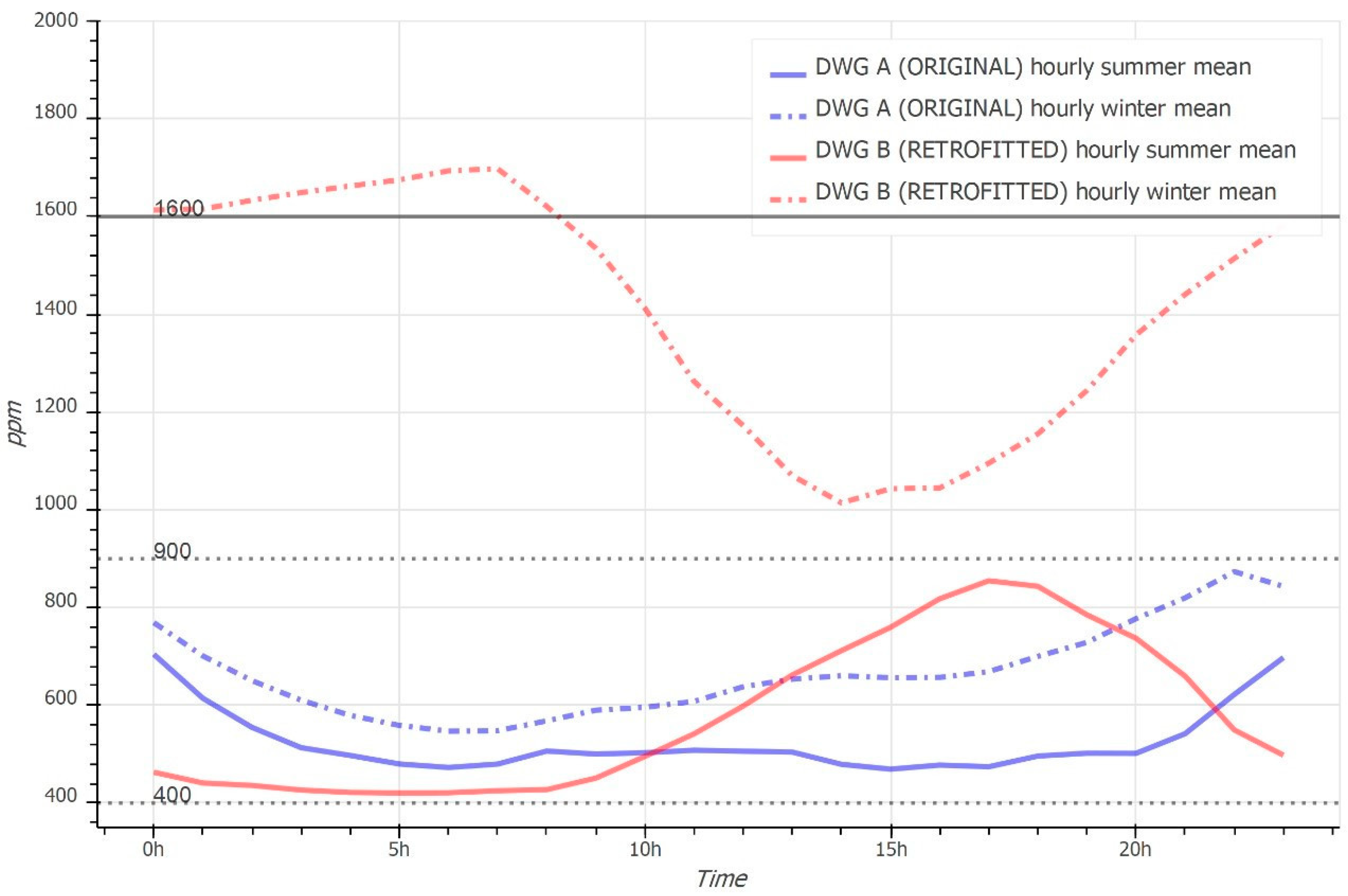
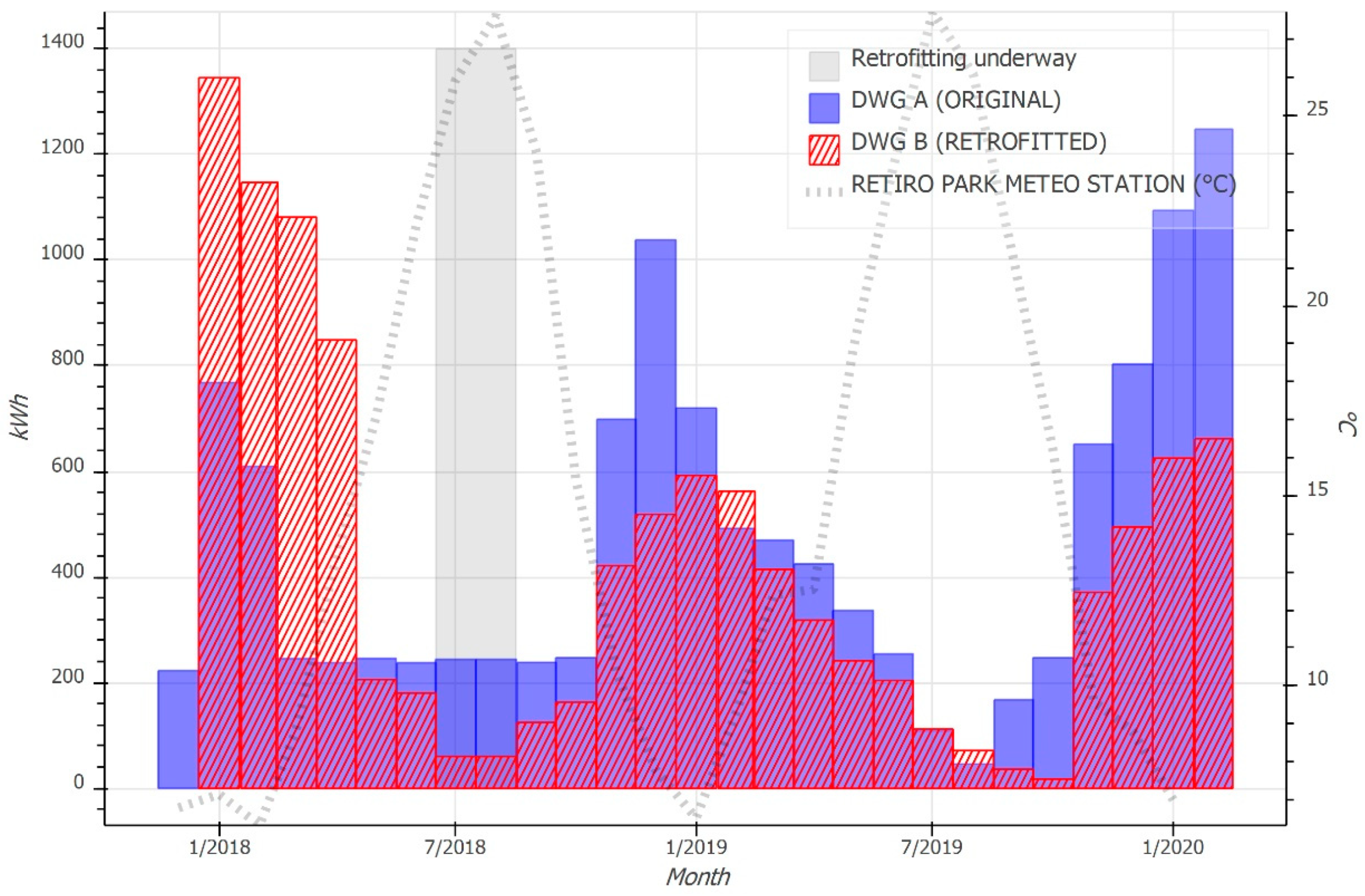
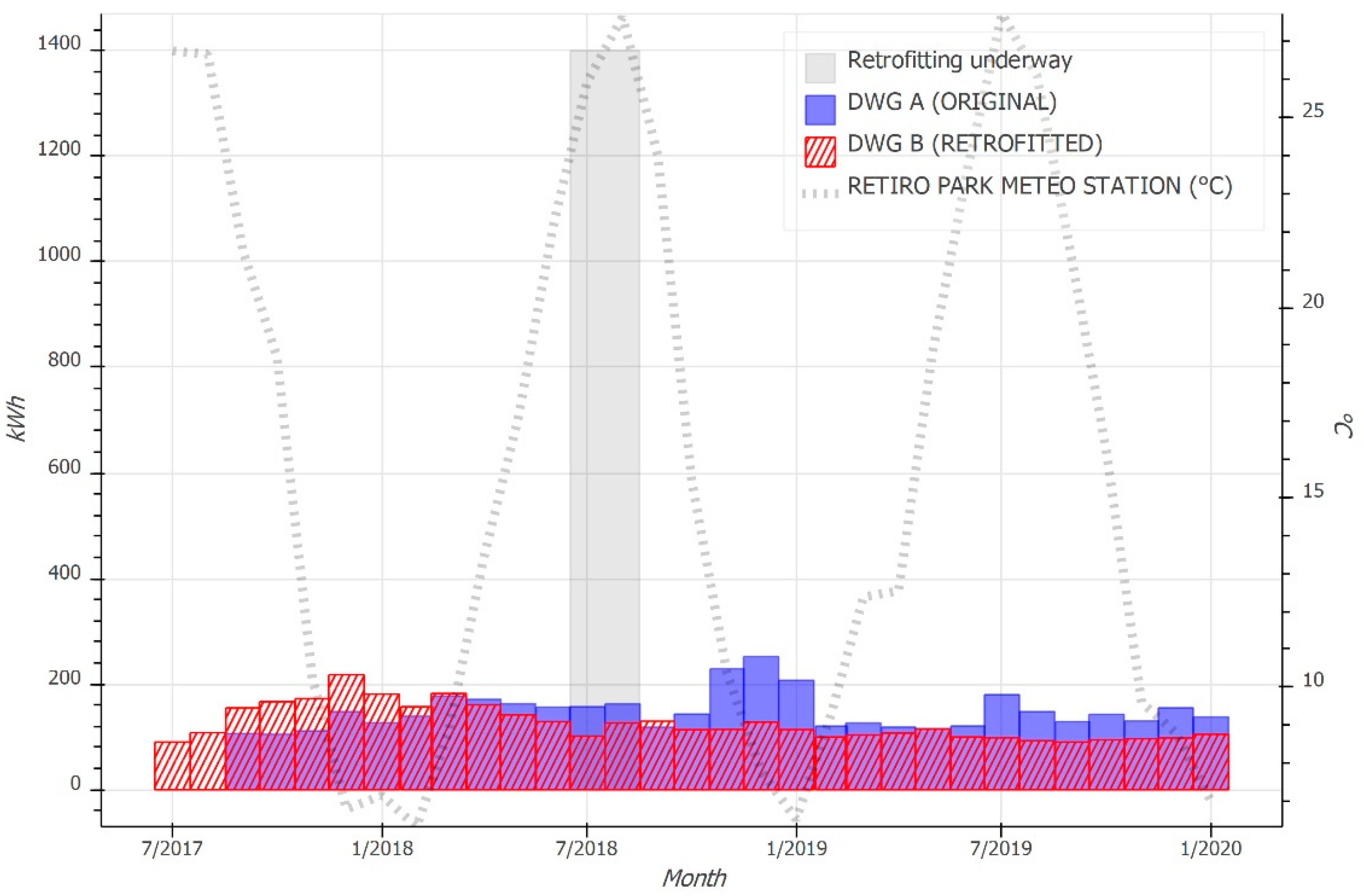
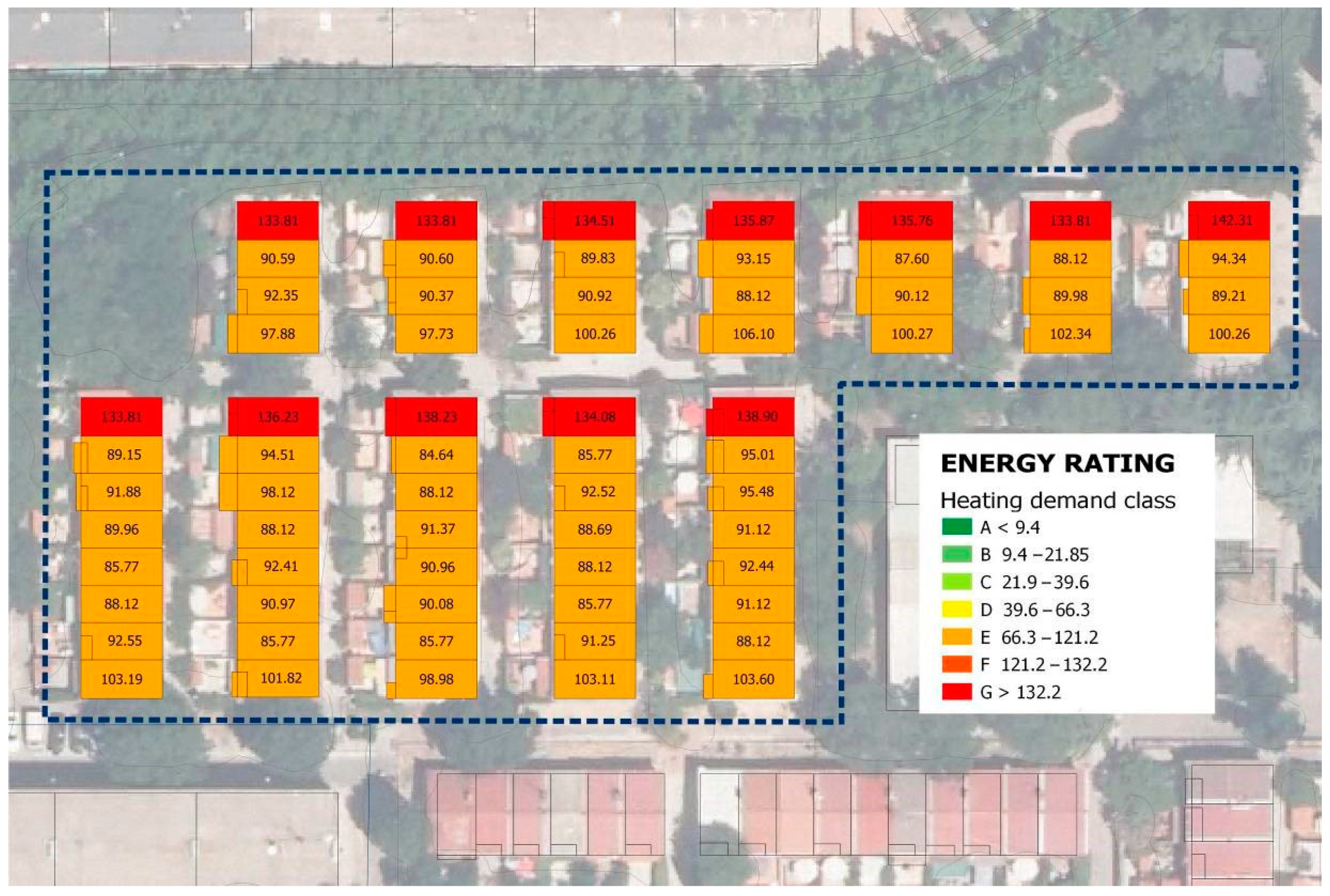
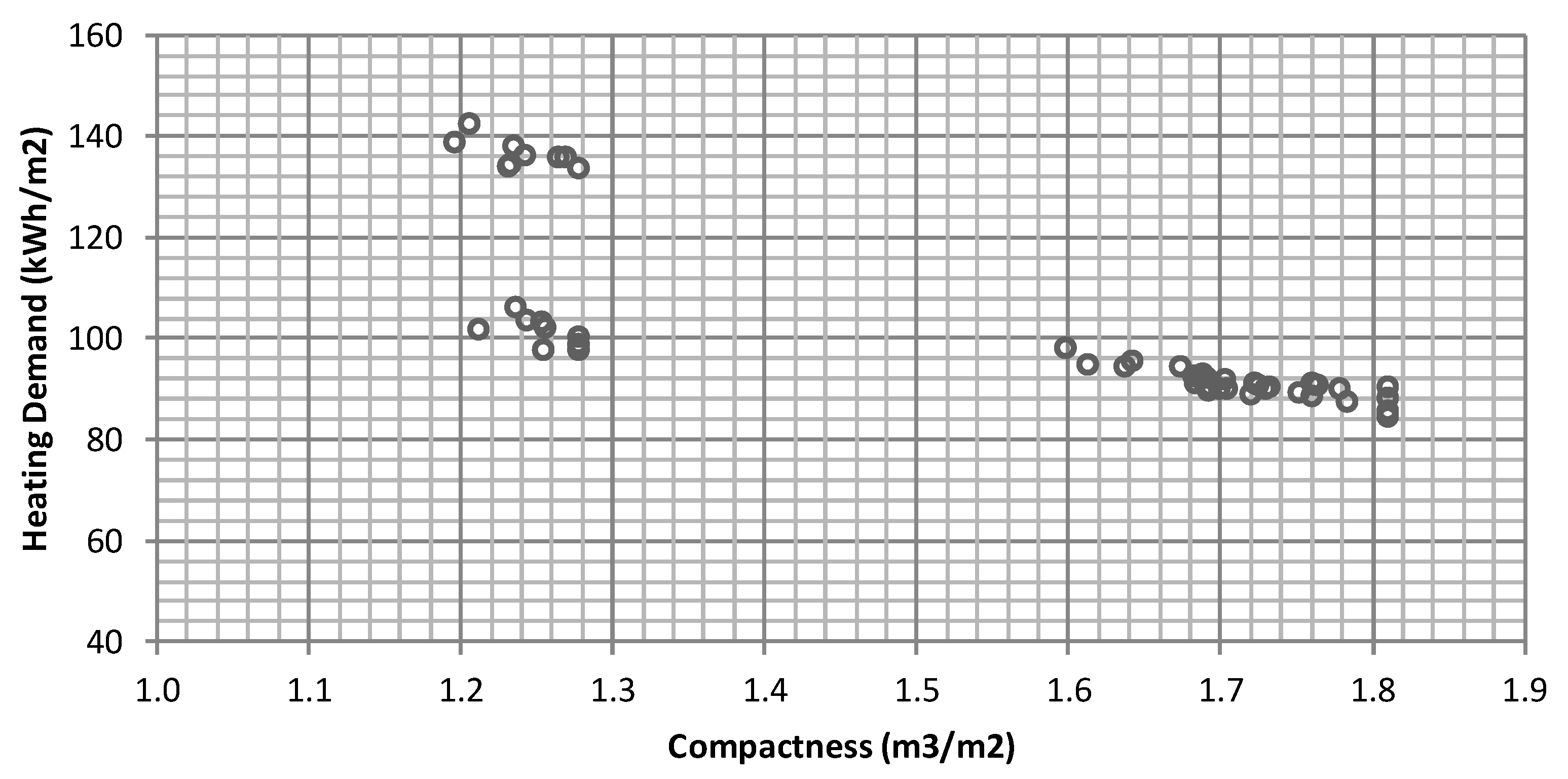

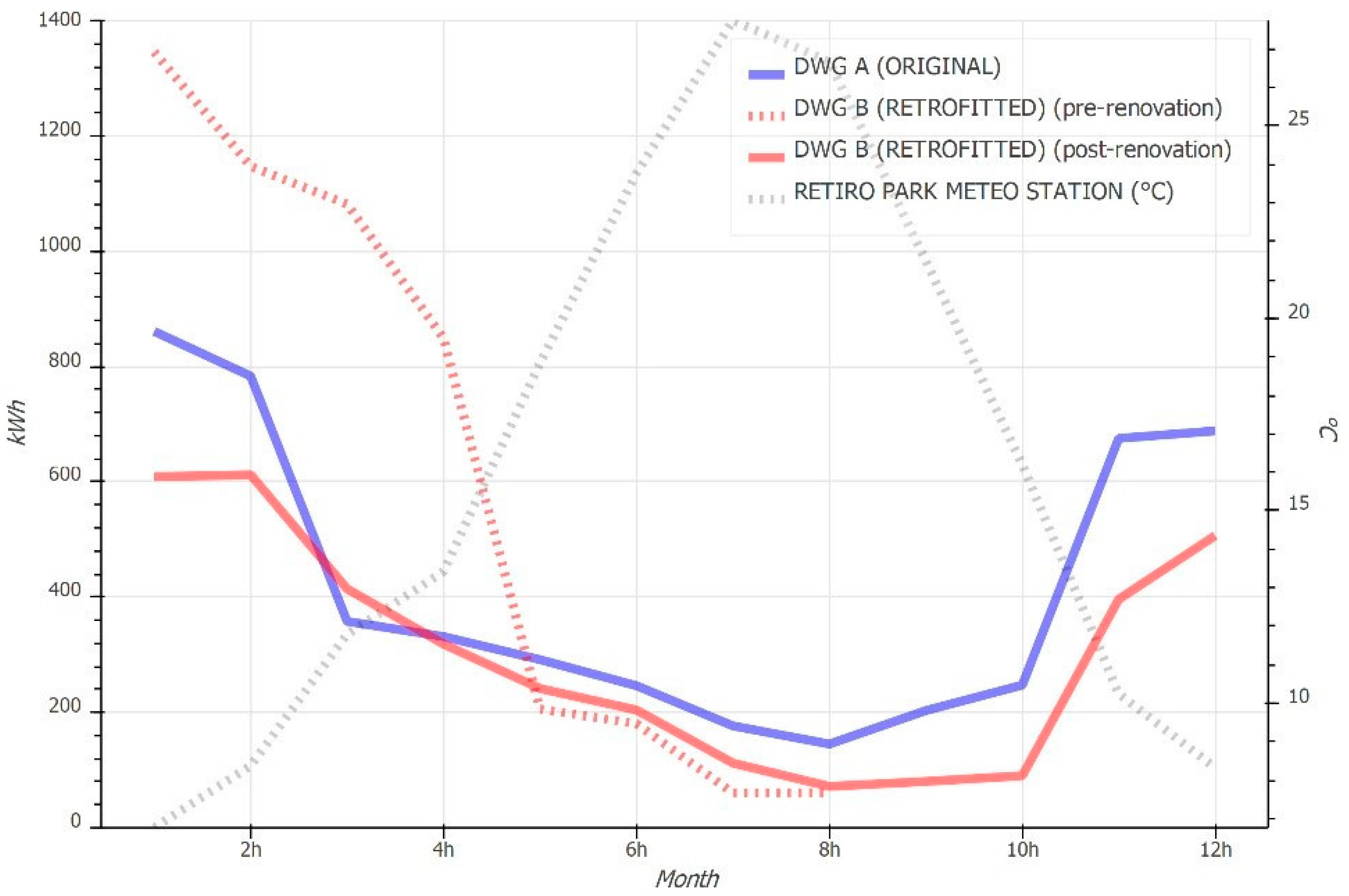
| Variable | ORIGINAL (DWG A) | RETROFITTED (DWG B) |
|---|---|---|
| Year built/renovated | 1965 * | 2017 |
| Gross floor area (m2) | 79.44 * | 79.44 * |
| Net floor area (m2) | 78 * | 78 * |
| Roof area (m2) | 39.72 * | 39.72 * |
| Area of floor in contact with the soil (m2) | 39.72 * | 39.72 * |
| Number of storeys | 2 * | 2 * |
| East façade area (m2) | 25.65 ** | 25.65 ** |
| West façade area (m2) | 25.65 ** | 25.65 ** |
| North façade area (m2) | 54.6 ** | 54.6 ** |
| Gross façade area (m2) | 105.9 | 105.9 |
| Area of openings (m2) | 11.6 *** | 11.86 *** |
| Net façade area (m2) | 94.3 * | 94.04 * |
| Percentage of openings | 12.3% | 12.6% |
| Total envelope area (m2) | 185.34 | 185.34 |
| COMPACTNESS RATIO (m3/m2) | 1.3 | 1.3 |
| Roof u-value (W/(m2.K)) | 2.4 ** | 0.31 **** |
| Floor u-value (W/(m2.K)) | 1 ** | 1 ** |
| Façade u-value (W/(m2.K)) | 1.55** | 0.3 **** |
| Opening u-value (W/(m2.K)) | 3.52 ** | 1.5 **** |
| Overall energy loss rate (W/(m2.K)) | 1.8 | 0.5 |
| Step in the methodology | Addressed variable | Scope |
|---|---|---|
| 1- HABITABILITY MONITORING Sensors | Comfort: - Temperature (°C) - Relative humidity (%) | Case studies Dwellings A and B |
| Air quality: - CO2 (ppm) | ||
| 2- CONSUMPTION Metered | Natural gas (kWh) - Heating - DHW | Case studies Dwellings A and B |
| Electricity (kWh) - Other purposes (cooling, kitchen, lighting, appliances…) | ||
| 3- SIMULATION MODEL | Theoretical consumption - Heating energy demand - Energy for ‘other purposes’ | Urban complex |
| 4- ANALYSIS/CALIBRATION | Assessment: - Theoretical consumption - Consumption metered - Habitability conditions | Urban complex |
| Variable | Value |
|---|---|
| CO2 measuring range | 0–2000 ppm (2001 ppm to 9999 ppm outside specified range) |
| Precision of CO2 measurements | 50 ppm ±5 % |
| Resolution | 1 ppm (0 ppm to 100 ppm) |
| Measuring technology | NDIR (non-dispersive infrared) sensors |
| Temperature range | −10 °C to... +60 °C |
| Precision | ±0.6 °C |
| Resolution | 0.1 °C |
| Relative humidity | 5 % to 95 % |
| Precision | 10 % to 90 % (at 25 °C ±3 % or ±5 %) |
| Resolution | 0.1 % |
| Memory | 5300 series of values |
| Data items accommodated | Up to 16 000 |
| Measuring interval | 3/10/30 s 1/3/10/30 min 1/3/4 h |
| Power supply | 5 V/0.5 A AC mains connector |
| Dimensions | 120 × 100 × 110 mm |
| Variable | DWG A (ORIGINAL) | DWG B (RETROFITTED) |
|---|---|---|
| Tenure | Ownership | Ownership |
| Occupancy during the period analyzed | 2 | 4/3 |
| Report summertime comfort | Yes | Yes |
| Report winter time comfort | No | No |
| Heating powered by | Natural gas | Natural gas |
| Heating target temperature (°C) | 20 | 18.5 |
| DHW powered by | Natural gas | Natural gas |
| Cooling powered by | Electricity | - |
| Ventilation | None reported | 30 min daily, in the morning |
| Maximum demand contracted (kW) | 5 | 3.45 |
| Lighting | LED | LED and low power |
| DWG A–ORIGINAL | DWG B–RETROFITTED | |
|---|---|---|
| Mean | 616.04 | 1081.46 |
| Cumulative | 39,898.5 | 2,608,737.5 |
| DWELLING A | DWELLING B | |||||
|---|---|---|---|---|---|---|
| Date | Electricity (kWh) | Natural Gas (kWh) | State | Electricity (kWh) | Natural Gas (kWh) | State |
| 2017-07 | Original | 90.09 | Original | |||
| 2017-08 | Original | 108.04 | Original | |||
| 2017-09 | 106.42 | Original | 154.86 | Original | ||
| 2017-10 | 105.26 | Original | 166.49 | Original | ||
| 2017-11 | 111.57 | Original | 172.29 | Original | ||
| 2017-12 | 148.11 | 223 | Original | 217.61 | Original | |
| 2018-01 | 126.95 | 768.11 | Original | 181.01 | 1345.4 | Original |
| 2018-02 | 139.43 | 609.55 | Original | 157.16 | 1147.1 | Original |
| 2018-03 | 177.46 | 245.9 | Original | 182.37 | 1081.5 | Original |
| 2018-04 | 171.38 | 238 | Original | 160.78 | 848.89 | Original |
| 2018-05 | 162.76 | 246.06 | Original | 141.83 | 205.86 | Original |
| 2018-06 | 156.32 | 237.9 | Original | 129.09 | 180.45 | Original |
| 2018-07 | 157.14 | 244.33 | Original | 101.36 | 60.37 | Retrofitting underway |
| 2018-08 | 162.62 | 244.33 | Original | 126.21 | 60.37 | Retrofitting underway |
| 2018-09 | 118.46 | 238.5 | Original | 129.72 | 124.65 | Retrofitted |
| 2018-10 | 143.18 | 247.51 | Original | 113.77 | 163.02 | Retrofitted |
| 2018-11 | 229.17 | 698.81 | Original | 114.17 | 421.6 | Retrofitted |
| 2018-12 | 252.2 | 1038.5 | Original | 127.85 | 518.63 | Retrofitted |
| 2019-01 | 207.23 | 720.08 | Original | 113.92 | 592.44 | Retrofitted |
| 2019-02 | 120.38 | 492.21 | Original | 99.68 | 562.37 | Retrofitted |
| 2019-03 | 126.34 | 469.93 | Original | 103.63 | 414.33 | Retrofitted |
| 2019-04 | 118.63 | 425.08 | Original | 107.22 | 318.5 | Retrofitted |
| 2019-05 | 115.78 | 337.04 | Original | 114.85 | 241.48 | Retrofitted |
| 2019-06 | 120.77 | 254.74 | Original | 99.7 | 204.19 | Retrofitted |
| 2019-07 | 179.97 | 109.08 | Original | 98.37 | 112.13 | Retrofitted |
| 2019-08 | 148 | 46.02 | Original | 92.8 | 71.69 | Retrofitted |
| 2019-09 | 129.03 | 167.99 | Original | 90.11 | 36.1 | Retrofitted |
| 2019-10 | 142.78 | 247.46 | Original | 94.56 | 17.4 | Retrofitted |
| 2019-11 | 130.66 | 651.85 | Original | 96.72 | 370.88 | Retrofitted |
| 2019-12 | 155.02 | 803.26 | Original | 98.12 | 494.59 | Retrofitted |
| 2020-01 | 137.66 | 1094.37 | Original | 104.84 | 625.18 | Retrofitted |
| 2020-02 | 1248.04 | Original | 662 | Retrofitted | ||
| DWG A | DWG B | ||||||
|---|---|---|---|---|---|---|---|
| State | Original | Original | Retrofitted | ||||
| Month | Electricity (kWh) | Natural Gas (kWh) | Electricity (kWh) | Natural Gas (kWh) | Electricity (kWh) | Natural Gas (kWh) | |
| 01 | January | 157 | 861 | 181 | 1345 | 109 | 609 |
| 02 | February | 130 | 783 | 157 | 1147 | 100 | 612 |
| 03 | March | 152 | 358 | 182 | 1082 | 104 | 414 |
| 04 | April | 145 | 332 | 161 | 849 | 107 | 319 |
| 05 | May | 139 | 292 | 142 | 206 | 115 | 241 |
| 06 | June | 139 | 246 | 129 | 180 | 100 | 204 |
| 07 | July | 169 | 177 | 96 | 60 | 98 | 112 |
| 08 | August | 155 | 145 | 117 | 60 | 93 | 72 |
| 09 | September | 118 | 203 | 155 | 110 | 80 | |
| 10 | October | 130 | 247 | 166 | 104 | 90 | |
| 11 | November | 157 | 675 | 172 | 105 | 396 | |
| 12 | December | 185 | 688 | 218 | 113 | 507 | |
| Total | 1776 | 5008 | 1876 | 4930 | 1258 | 3657 | |
| DWG A | DWG B | Average DWG * | ||
|---|---|---|---|---|
| Original | Not Retrofitted | Retrofitted | SPAHOUSEC I and II | |
| Gas consumption (kWh) | 4 983 1 | 6 130 1 | 3 478 1 | 13 862 2 |
| Electricity consumption (kWh) | 1 462 1 | 1 838 1 | 1 238 1 | - |
| TOTAL FEC (kWh) | 6 445 1 | 7 968 1 | 4 716 1 | 15 119 2 |
| Total heating (55 % of overall total) (kWh) | 3 545 3 | 4 382 3 | 2 594 3 | 8 315 2 |
| Gas per unit of area (kWh/m2) | 63.1 1 | 77.6 1 | 44.0 1 | 105.0 2 |
| Electricity per unit of area (kWh/m2) | 18.5 1 | 23.3 1 | 15.7 1 | - |
| TOTAL per unit of area (kWh/m2) | 81.6 1 | 100.9 1 | 59.7 1 | 114.5 2 |
| Heating per unit of area (55 %) (kWh/m2) | 44.9 3 | 55.5 3 | 32.8 3 | 63.0 2 |
| Complex | North (12 Units) | Intermediate (12 Units) | South (12 Units) | TOTAL (68 Units) |
|---|---|---|---|---|
| Compactness ratio (m3/m2) | 1.3 | 1.7 | 1.3 | 1.6 |
| Htng demand/unit area (kWh/m2) | 133 | 92 | 101 | 100 |
| Relative to dwellings monitored | 100% | 69% | 76% | 75% |
| ORIGINAL STATE-baseline scenario | ||||
| Gas consumption | 5556 | |||
| Electricity consumption | 1650 | |||
| TOTAL consumption (kWh) | 7206 | 4985 | 5472 | 371,477 |
| Heating consumption (55 %) (kWh) | 3963 | 2742 | 3010 | 204,313 |
| RETROFITTED STATE-improved scenario | ||||
| Gas consumption | 3153 | |||
| Electricity consumption | 1111 | |||
| TOTAL consumption | 4264 | 2950 | 3238 | 219,814 |
| Heating consumption | 2345 | 1622 | 781 | 120,898 |
| Savings (kWh/year) | 151,663 | |||
Publisher’s Note: MDPI stays neutral with regard to jurisdictional claims in published maps and institutional affiliations. |
© 2020 by the authors. Licensee MDPI, Basel, Switzerland. This article is an open access article distributed under the terms and conditions of the Creative Commons Attribution (CC BY) license (http://creativecommons.org/licenses/by/4.0/).
Share and Cite
Martín-Consuegra, F.; de Frutos, F.; Oteiza, I.; Alonso, C.; Frutos, B. Minimal Monitoring of Improvements in Energy Performance after Envelope Renovation in Subsidized Single Family Housing in Madrid. Sustainability 2021, 13, 235. https://doi.org/10.3390/su13010235
Martín-Consuegra F, de Frutos F, Oteiza I, Alonso C, Frutos B. Minimal Monitoring of Improvements in Energy Performance after Envelope Renovation in Subsidized Single Family Housing in Madrid. Sustainability. 2021; 13(1):235. https://doi.org/10.3390/su13010235
Chicago/Turabian StyleMartín-Consuegra, Fernando, Fernando de Frutos, Ignacio Oteiza, Carmen Alonso, and Borja Frutos. 2021. "Minimal Monitoring of Improvements in Energy Performance after Envelope Renovation in Subsidized Single Family Housing in Madrid" Sustainability 13, no. 1: 235. https://doi.org/10.3390/su13010235
APA StyleMartín-Consuegra, F., de Frutos, F., Oteiza, I., Alonso, C., & Frutos, B. (2021). Minimal Monitoring of Improvements in Energy Performance after Envelope Renovation in Subsidized Single Family Housing in Madrid. Sustainability, 13(1), 235. https://doi.org/10.3390/su13010235





